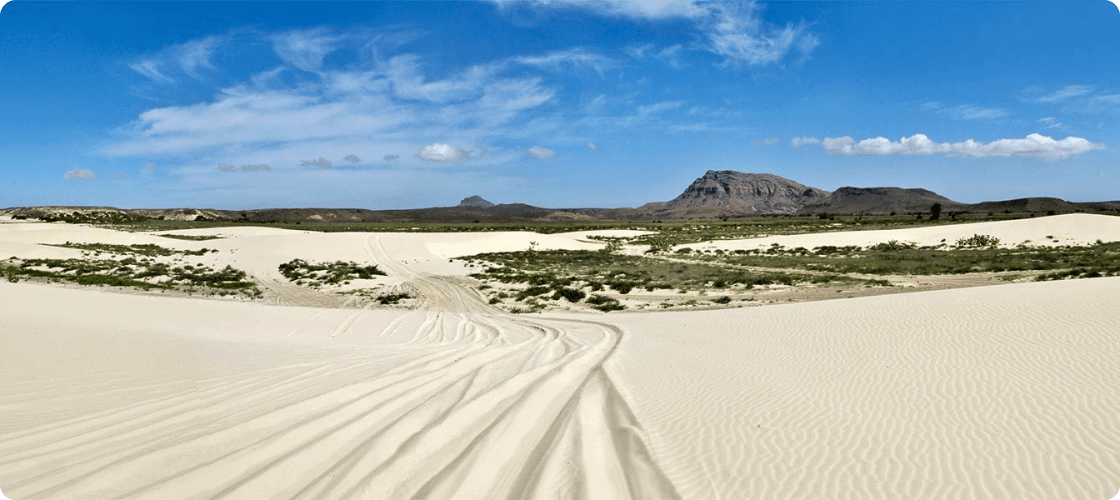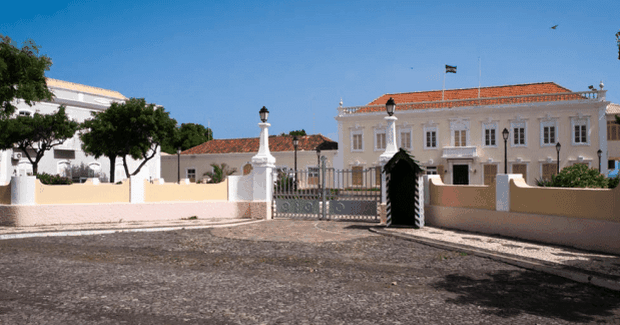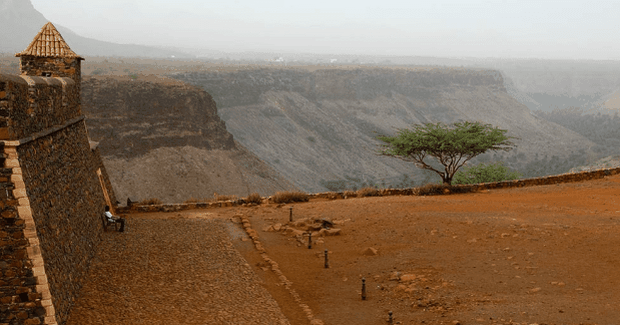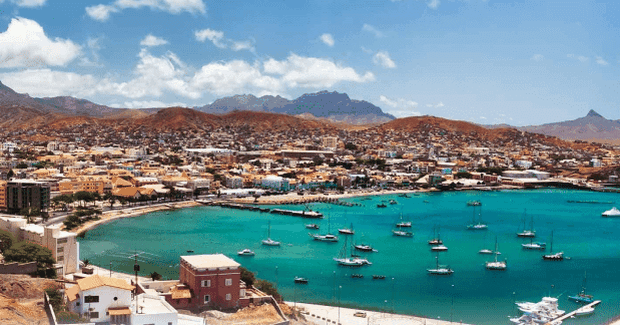Digital Nomad Visa for Cabo Verde

Quick Visa Facts
Visa length N/A
Possible to extend? N/A
Who can apply? N/A
Minimum Income Requirements N/A
Time for visa applications N/A
Want to know if you can apply?
Complete a visa quiz and see if you qualify!
Quick facts about Cabo Verde
Cabo Verde is a beautiful archipelago located in the Central Atlantic Ocean. It consists of 10 volcanic islands between 600 to 850 kilometers apart located west of Senegal in West Africa. Each island is different from the other, so there is so much to explore in this stunning archipelago. And now, there is a digital nomad visa for Cabo Verde which allows nomads to live and work there!
Capital Praia
Form of Government Semi-presidential republic
Population 555,988 as of 2020
Climate Dry tropical climate
Language Portuguese
Currency Cape Verdean Escudo (CVE)

Join the Cabo Verde community!
Join the community of remoters!
Living in Cabo Verde as a digital nomad
Cabo Verde is a destination that has been catching the attention of many digital nomads in recent years. Its location in the Atlantic Ocean makes it the perfect place for those looking for a tropical climate and a relaxing atmosphere.
Cabo Verde launched their digital nomad visa in December 2020. It was dubbed Cabo Verde Remote Working Program, in which digital nomads can get a temporary permit for six months with the option to renew.
Cabo Verde has a lot of exciting things to offer. It quickly became a hotspot for remote workers due to its rich culture, stunning landscapes, and welcoming people.
Attractions and best places to visit
The archipelago is made up of 10 islands: Santiago, Santo Antão, Boa Vista, Fogo, São Nicolau, Maio, São Vicente, Sal, Brava and Santa Luiza. Each island offers something unique and different.

Sal is a famous holiday spot because of its beautiful white sand beaches and resorts. Sal, together with Boa Vista, is also famous for watersports. People often practice sailing, windsurfing, scuba diving, kite surfing, and many more activities on the water.
Bao Vista is also the site of Ervatão Beach, which is home to one of the world’s third-largest loggerhead turtle nesting sites. Also, Bao Vista’s waters are breeding grounds for humpback whales, so they offer plenty of whale-watching tours.
The island of Fogo is famous for Pico do Fogo, an active volcano. Many tourists visit the island for the hiking trails that are close to the volcano.
As you can see, there are plenty of things to do throughout every island in Cabo Verde!
Digital Nomad Hotspots
Cabo Verde has seven working airports. Four of them operate as international airports but the islands are also reachable by boat and ferries.
The capital city of Cabo Verde, Praia, is usually a hotspot for tourists and digital nomads. The city is located on the island of Santiago, and you will find many remote workers living there with whom you can connect.
Tourists mainly frequent the island of Sal, but if you enjoy sightseeing and adventuring while you work remotely, then it is a place for you. Similarly, the island of Boa Vista also has a lot to offer for digital nomads with beautiful beaches and an even more beautiful culture.
Cost of Living
The currency of Cabo Verde is the Cape Verdean Escudo (CVE). The euro is used as a second currency, so you will find a lot of prices in euros. People will accept euros or escudos, and many businesses will change euros even if you paid in escudos. 1 EUR equals 110 CVE.
People use mostly cash in Cabo Verde. There are plenty of banks with ATMs that accept Visa and MasterCard, so you can quickly withdraw money. Very rarely are credit card payments accepted. In fact, only fancy places are known to accept credit cards, and they usually charge you a 3% fee.
Cabo Verde is relatively cheap, but it has plenty of tourist traps. So, try to shop at local markets and eat where the locals do to avoid higher prices.
You can find Airbnb apartments for €23 a night or a hotel room for €20, and a cheap meal at a restaurant for €3. You can also find car rentals for €50.
You can easily live on a budget while in Cabo Verde, needing to spend around €760 a month. If you have more room in your budget, you can comfortably live for €1800 a month.
Digital Nomad Essentials
There are ups and downs regarding the internet in Cabo Verde. You’ll see many places offering free wifi around the islands, but sometimes it will not work properly, or it’ll be limited to 2GB. On the other hand, mobile internet has excellent coverage and even the smallest villages have at least 3G. Getting a SIM card isn’t so hard either, so you can get one when you arrive and always hotspot to your phone if needed.

The main provider is CVMovel, and it has excellent coverage at a good price point. A simple plan of 1GB costs around €4.50, and a bigger package with 5GB costs around €11.50.
Sadly, CVMovel is not too friendly for personal hotspots, especially on IOS. So make sure to bring a non-Apple device to share the internet with other devices.
Additionally, there are plenty of cafes and restaurants where you can work. They’re spread out on all the islands, but you can find more in Praia, Sal, and Sao Vicente.

Our Community Drives it all
Join the community of remoters!
Visa Overview
Cabo Verde implemented their digital nomad visa in December 2020. It is called Cabo Verde Remote Working Program. It allows remote workers to have a temporary work and tourism visa for six months. You can also renew it after your time is up to stay longer.
The Cabo Verde Remote Working Program is meant for self-employed workers and anyone working remotely. It is open for those who use the internet and other electronic and communication tools to do their work, without the need of a fixed office.
This visa is available to individuals and people who wish to bring their families with them. Cabo Verde opens its doors to anyone interested in living in this stunning set of islands.
The visa offers the opportunity for people to explore the peace and tranquility Cabo Verde has to offer. The locals are incredibly welcome and hospitable towards visitors. You will be able to immerse yourself in the culture and history of these islands, building community and enjoying the warm weather. What else could you ask for?
Current travel restrictions
Like any other country in the world, Cabo Verde has been greatly affected by the pandemic and the aftermaths of COVID-19. So now it has certain travel restrictions you should consider if you’re planning on moving to Cabo Verde.
Register and pay for the airport fee (€30)
Show a valid vaccination certification or present a negative result of a PCR (72hrs) or Antigen test (48hrs) before your travel.
Fill out the health monitoring form.
Hotel reservation or place where you’ll be hosted during your stay.
Your temperature will be taken upon arriving at the airport. If your temperature is higher than 37.5°C, you will be sent to an isolated room for further examination.

Our Community Drives it all
Join the community of remoters!
Who Can Apply for the Digital Nomad Visa for Cabo Verde

The digital nomad visa for Cabo Verde is available to anyone from Europe, North America, the Community of Portuguese Speaking Countries (CPLP), and the Economic Community of West African States (CEDEAO).
You’ll need a valid passport to enroll in the program for six months. Additionally, you’ll need to show proof of income. If you’re applying as an individual, you’ll need an average bank balance of €1500 over the last six months. If you’re applying as a family, you’ll need an average bank balance of €2700 over the last six months.
Additionally, you’re required to have travel and health insurance with coverage for evacuation and body transportation in case of your death.
You can submit your application online by filling out the form provided here!
How to Apply for the Digital Nomad Visa for Cabo Verde
Documents required to apply for the Cabo Verde digital nomad visa
Valid passport – valid for six months.
Remote income – you must work as a freelance or be an employed individual for a company outside of Cabo Verde.
Proof of income – You must show you’ve had an average of €1500 in your bank account for the last six months.
Complete the application – Fill out the form and submit it to the Cabo Verde portal.
Citizenship – You must be from Europe, North America, the Community of Portuguese Speaking Countries (CPLP), and the Economic Community of West African States (CEDEAO).
Health insurance
Proof of accommodation
Criminal background check
Pay visa fee
How much does it cost?
To obtain the digital nomad visa, you must pay a small fee.
The processing fee is €20 per person. Additionally, you must pay €34 upon arrival at the airport.

Our Community Drives it all
Join the community of remoters!
Timeline for Applying
The application process is very straightforward.

The first step is to fill out the application online. You must submit the following documents:
Passport size photo of the candidate(s)
Passport bio page of the candidate(s)
Proof of income and means of subsistence
Individual health and travel insurance or family package
Copy of booking accommodation
After submitting the application, you’ll have to wait for it to be processed. This usually takes around two weeks. Then you will receive an email with the next steps to move forward to obtain the visa.
Cabo Verde is a great nomad base for digital nomads who love the water, sunshine, and a relaxed pace of life. The visa is inexpensive and easy to obtain, making it super accessible to anyone curious to check it out. While there are other islands that offer more consistent, stable internet connections, you can still make due when you’re in the main towns.
Interested in other digital nomad visa options? Why not check out Mauritius, Spain or Malta!
Author
Nadia Dardón is a freelance writer from Guatemala. In early 2022 she embarked as a digital nomad, traveling through Europe, focusing mostly on the literary history of each country. She has worked fully remotely for the past four years as a reader, writer, and content creator with experience creating pieces for different industries. She also has a personal blog where she writes about her cultural and literary travels.